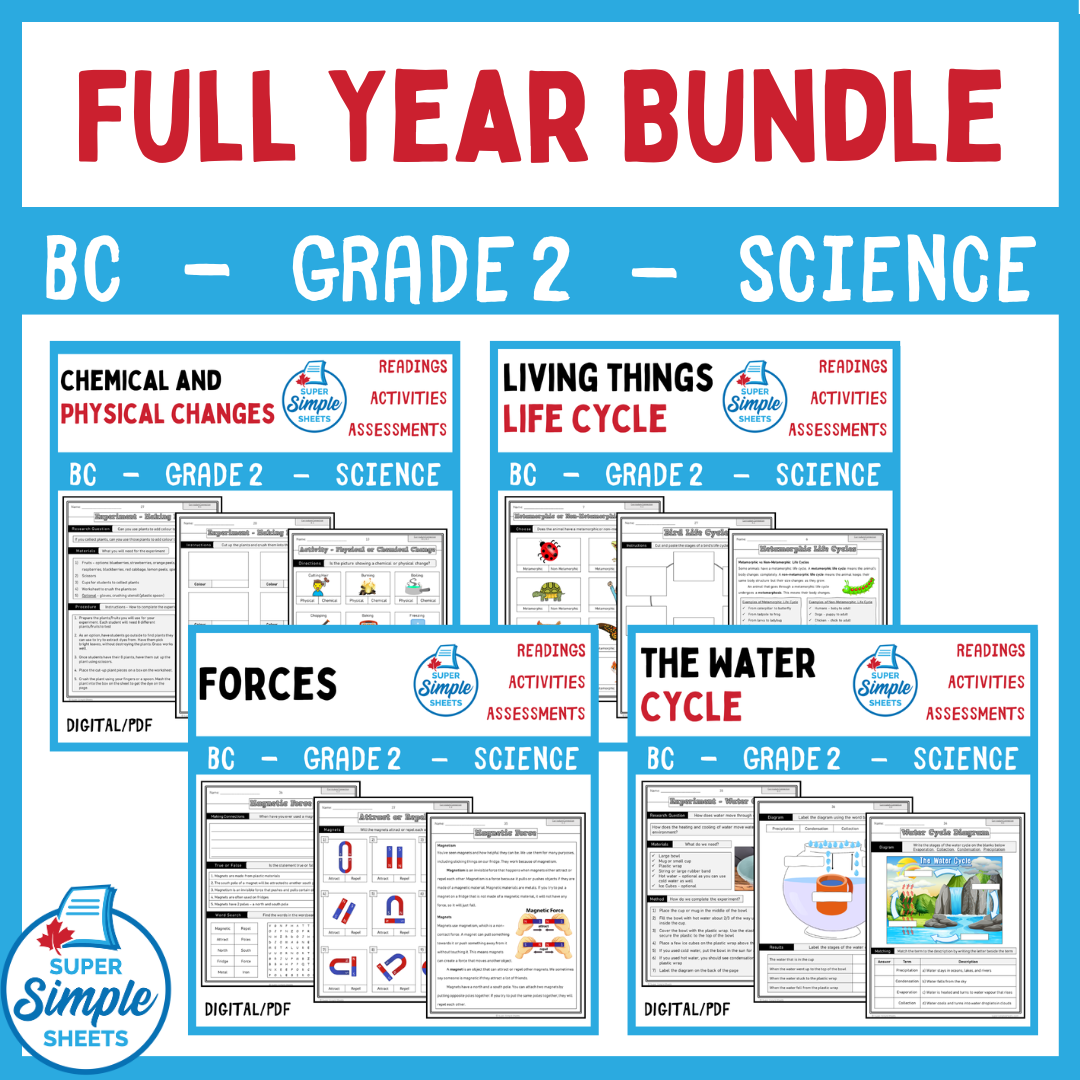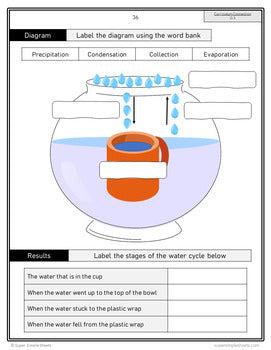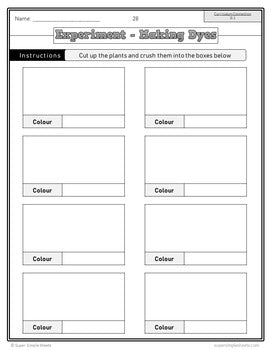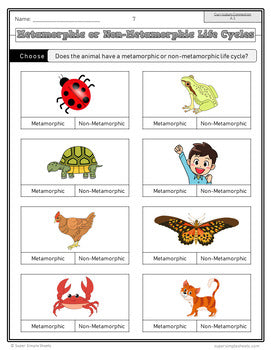BC Grade 2 Science Full Year Bundle
BC Grade 2 Science Full Year Bundle
Interested in a bundle? Shop below instead!
Couldn't load pickup availability
PRODUCT PREVIEW
PDF AND GOOGLE SLIDE VERSIONS BOTH INCLUDED!
British Columbia (BC) 2016 Science Curriculum - Grade 2. This product was created to cover all topics in the 2016 BC Science Grade 2 curriculum
There are 380+ activity sheets that cover the elaborations and big ideas in the science curriculum. This massive unit contains readings, surveys, cut and paste activities and a variety of fun activities – drawings, word searches, matching, word scrambles, fill in the blanks, and more!
We have added STEM activities as well as hands on experiments for students to learn the content in the curriculum.
Check out the previews of these units to learn more about how it can benefit your students. We know you will love this no-prep, just print or upload to Google, time-saving resource!
Living Things Life Cycles
Some of the concepts that are covered:
- Metamorphic life cycles
- Non-metamorphic life cycles
- Types of animals - amphibians
- Frog life cycle – diagram, reading, and activities
- Types of animals - insects
- Butterfly life cycle – diagram, reading, and activities
- Ant life cycle – diagram, reading, and activities
- Types of animals - mammals
- Mammal life cycle – diagram, reading, and activities
- Dog life cycle – reading response and drawing diagram
- Types of animals – reptiles
- Snake life cycle – reading response and drawing diagram
- Types of animals – fish
- Fish life cycle – colouring activity
- Types of animals – birds
- Bird life cycle – drawing the stages
- Types of animals – spiders
- Spider life cycle – fill in the blanks diagram
- Assignment - life cycle activity – making a book
- Food needs while growing – birds, mammals, and fish
- Food needs while growing – reptiles, insects, and amphibians
- Identify changes in animals
- Match baby animals to adult animals (foals, horses, calf, cow, etc.)
- Indigenous understanding of life cycles
- Conservation and sustainable practices by Indigenous groups
- Clam gardens
- Salmon fishing
- Poster assignment – sustainable practices
- Unit Test
- Answer pages for all activities
Chemical and Physical Changes
Some of the concepts that are covered:
- What are materials?
- Raw materials versus processed materials
- Changing raw materials
- Where we find raw materials
- Chemical versus physical changes to materials
- Physical changes – changing cotton
- Physical changes – cutting materials
- Activity – Step by step Origami (making animals and paper airplanes)
- How paper is made – physical and chemical changes
- Which steps in the process of paper making are physical and chemical?
- Physical changes – freezing/melting
- Experiment – whipping cream physical change
- Making dyes from plants – Indigenous methods
- Experiment – making dyes (using plants to stain page)
- Physical changes - wordsearch and word scramble
- Chemical changes to materials – colour change, bubbles, smell, a solid is made
- Experiment – hard boiling an egg
- Chemical change – burning
- Experiment – chemical changes – Bubble Bomb
- Materials – plastic profile
- How plastic is made – chemical and physical changes
- Making natural rubber – chemical and physical changes
- Chemical change activities – wordsearch and word scramble
- Unit test
- Answer pages for all activities
Forces
Some of the concepts that are covered:
- In what ways do objects move? (circular, straight line, zig-zag, up and down, back and forth)
- Activity – using code to program movements
- What forces cause objects to move?
- Push and pull forces causing objects to move
- Non-contact forces (at-a-distance forces) versus contact forces
- Gravity – readings, activities, and experiments
- Experiment – testing the force of gravity on different objects
- Electrostatic force – readings and questions
- Research – Isaac Newton
- Static electricity – reading and questions
- Dangers of static electricity
- Lightning – electrostatic force
- Magnetic forces – reading, activities, experiment
- Activity – repel or attract?
- Experiment – Magnetic car
- How does a compass work?
- Devices that use non-contact forces – magnetism, electrostatic, and gravity
- Contact forces – muscular force, friction, and spring force
- Friction – reading and questions
- Experiment – friction car ramp
- Experiment – demonstrating friction using rice and a pencil
- Muscular force – reading and questions
- Experiment – muscular force (throwing objects)
- Spring force – reading and questions
- Experiment – spring force popsicle stick catapult
- Unbalanced and balanced forces causing change in direction
- Examples of unbalanced and balanced forces
- Objects changing direction – sports examples
- Force diagrams – showing change in direction
- Forces in our everyday lives
- Forces of nature – tsunami (water force) and tornado (wind force)
- Unit test
- Answer pages for all activities
Water Cycle
Some of the concepts that are covered:
- Properties of water
- Bodies of water – lakes, oceans, seas, wetlands, ponds, rivers
- Watersheds
- Researching watersheds
- Freshwater around the world
- Cryosphere – glaciers
- Water in natural and built environments
- Groundwater – water table
- Experiment – creating a groundwater (water table) model
- Experiment - Making a water filter
- Evaporation – reading and questions
- Experiment – evaporation
- Condensation – reading and questions
- Experiment – condensation
- Water cycle – reading and questions
- Experiment – water cycle diagram
- Three states of water – ice, vapour, and liquid
- All living things need water
- Using water – transportation, recreation, and water power (hydro)
- Getting water into people’s homes – water towers
- Weather – coding supercomputers
- Assignment – meteorologists
- Research – weather report
- How humans affect freshwater – pollution
- Water conservation – reading, questions, and survey
- Indigenous methods of conservation
- How the Indigenous use water
- Unit test
- Answer pages for all activities
This is a comprehensive bundle that will save you hours of planning! It has been tested and found effective in helping students learn the big ideas in the curriculum.
Share





Absolutely love these resources! They have been a great addition to the practical, hands-on- things we do in class.
So easy to use, takes all the stress out of planning and prep. Some activities we do as a whole class, and some we use as centres.








